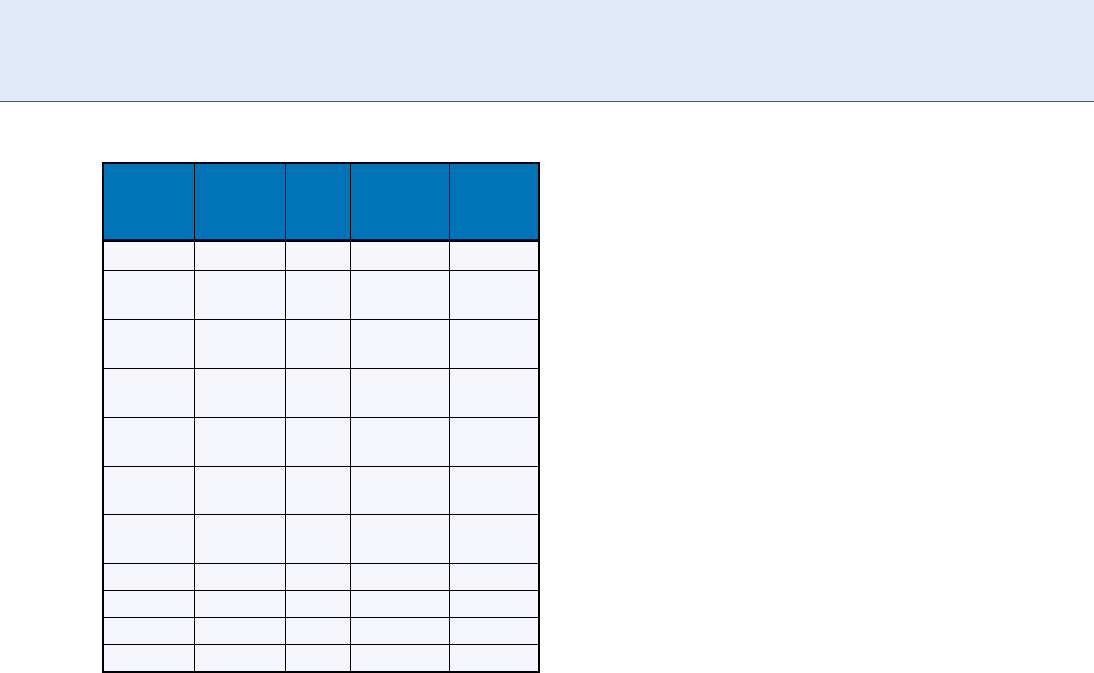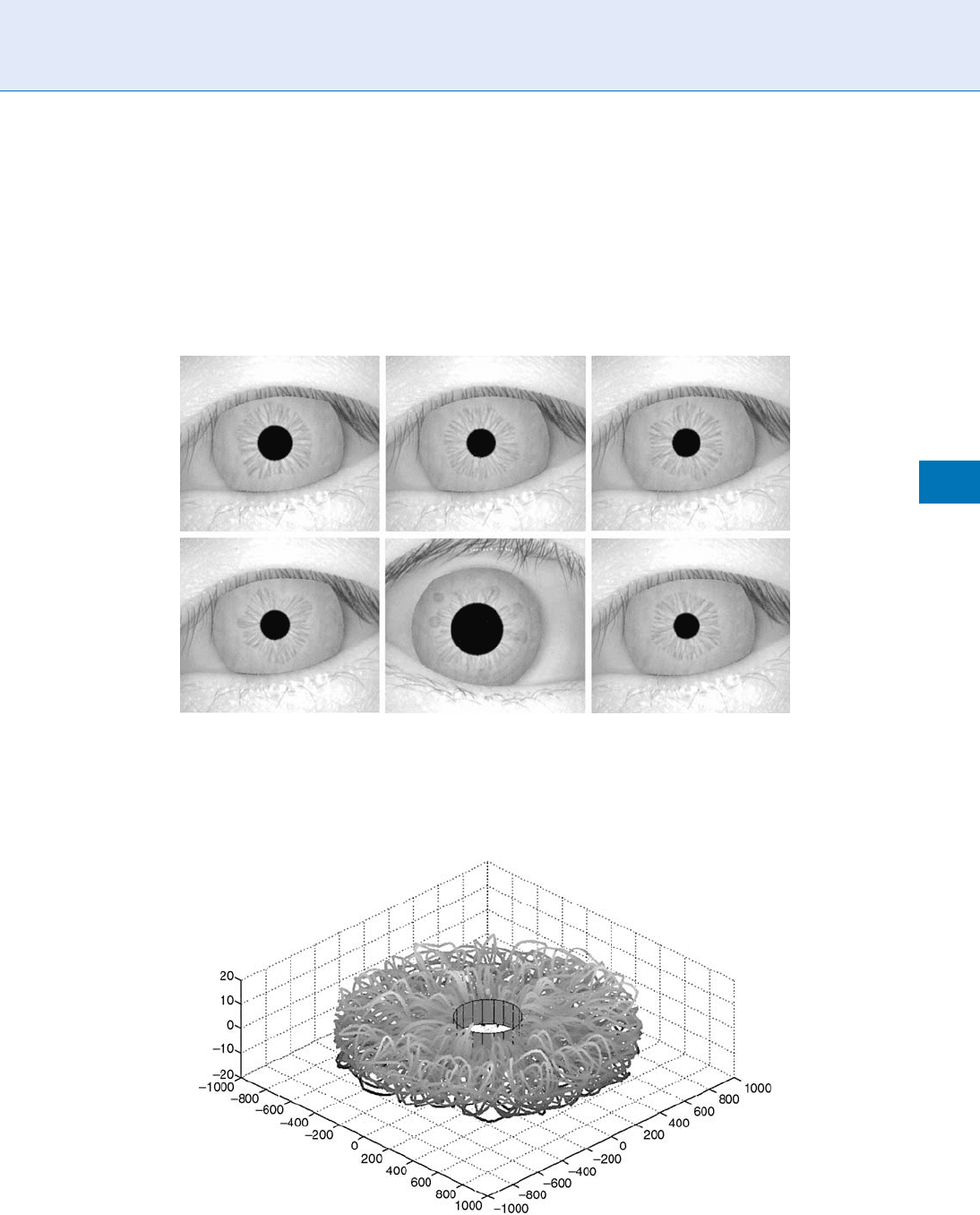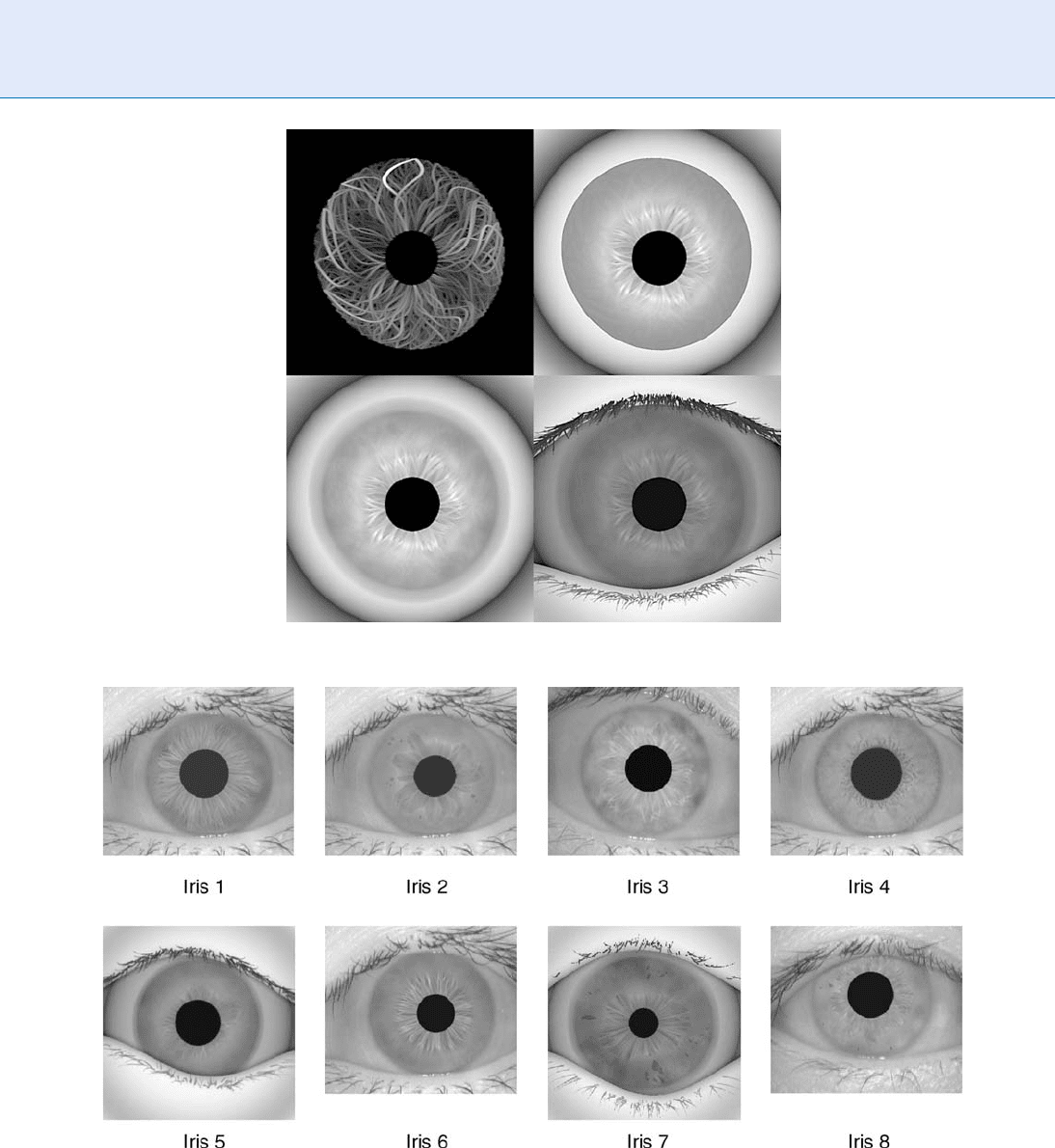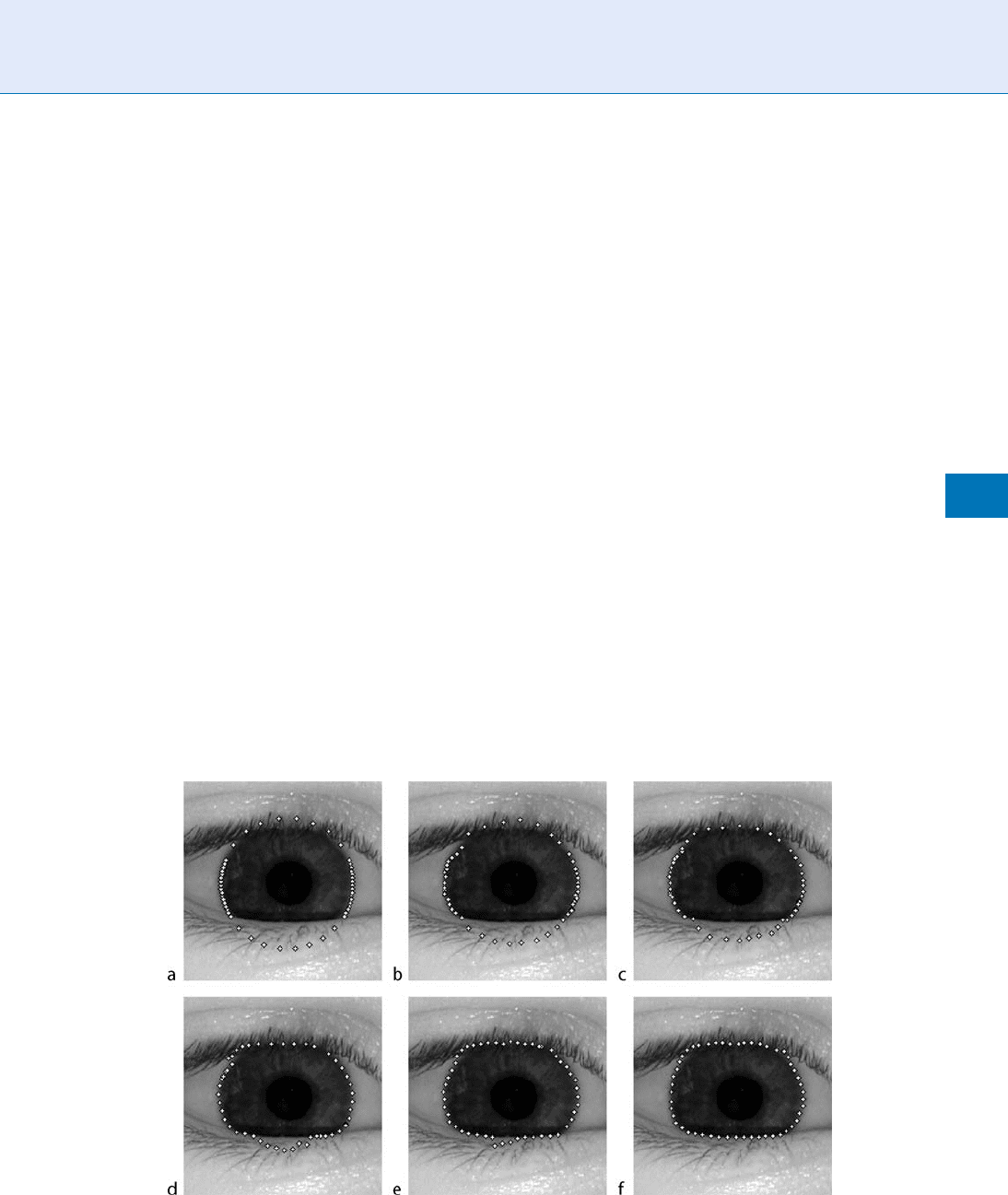Li S.Z., Jain A.K. (eds.) Encyclopedia of Biometrics
Подождите немного. Документ загружается.


Matrix X contains {x
i
} in its columns, and vector
u contains the peak constraints (1 for authentics,
0 for impostors).
The OTSDF filter accomplishes two goals: it pro-
duces sharp peaks for training images, by reducing
ACE, and it achieves tolerance to additive white
noise, by reducing ONV in Eq. (1). The resulting filter
gives good discrimination between authentic and
impostor patterns, even when the authentic patterns
are noisy.
Occlusion Metric
We need to have a metric for each local patch to
evaluate the probability of this local patch belonging
to an occluded region or a true iris pattern. We call
this metric as ‘‘occlusion metric’’. For every local pixel
x in a normalized iris map, we denote p(x) as the
occlusion metric.
There are some intuitive observations for estimat-
ing the occlusion metric for a particular patch.
For example, if we observe the second row of Fig. 2
(the normalized iris map), we will see that in most
cases, occlusion caused by eyelid happens in three
regions: upper-left corner, upper-center region and
the upper-right corner. Therefore, if the location of a
point is close to these three regions, first, it is more
likely to be an occluded region. Second, an occluded
region caused by eyelids usually has higher value of
pixel intensity. This is because in most cases eyelids
look brighter than iris texture. Third, if we observe
the occluded region in Fig. 3a and b, we would find
that usually the eyelid region contains textures of
irregular eyelashes. The line style of eyelashes in Carte-
sian coordinate is irregular. Some are straight, others
are curved. After unwrapping them into polar coordi-
nate, the shape of eyelashes become even more irregu-
lar. Therefore, they create irregular patterns on top of
the eyelids. One special thing about eyelashes is their
intensity is usually lower than iris texture. Therefore,
eyelashes on top of eyelids lead to a large standard
deviation of pixel intensity value in local region. This,
too, can be used as one feature to distinguish occlusion
from iris texture.
Based on the three observations mentioned above,
we compute four features for every pixel on a normal-
ized iris map. They are: (1) the mean intensity value
on a local patch, centered around that pixel; (2) the
standard deviation of the intensity value in that local
patch; (3) the percentage of pixels whose intensity is
greater than one standard deviation above the mean of
the entire iris plane; (4) the shortest Euclidean distance
from that pixel to one of the three ‘‘easily-occluded-
region’’. After computing these features, we train a
Fisher linear discriminant analysis (FLDA) model to
compute a single value to represent the probability of
this pixel being occluded. This FLDA model is trained
by using 30 iris texture maps whose occluded regions
are manually labeled.
Probabilistic Graphical Model
We have described the proposed probabilistic graphical
model in previous section. Now, let us think about how
to model the potential function of the nodes and
between those nodes in Fig. 3c. As described earlier,
for each patch, we have variables d
i
and o
i
, to model
the local shift and the occlusion, respectively. We can
combine the both into one variable, say h
i
¼ d
i
; o
i
½
T
,
and h
i
is a vector in three-dimensional space. For any
pair of neighboring vectors h
i
and h
j
, we can model
the possibility of observing them C
i;j
ðh
i
; h
j
Þ with the
following equation:
C
i;j
ðh
i
; h
j
Þ¼C
d;i;j
ðd
i
; d
j
ÞC
o;i;j
ðo
i
; o
j
Þð4Þ
The reason that we can decompose C
i;j
ðh
i
; h
j
Þ is
that we assume the local shift of the patch and
occlusion are statistically independent events. We can
further model C
d;i;j
ðd
i
; d
j
Þ and C
o;i;j
ðo
i
; o
j
Þ with the
following equation:
C
d;i;j
ðd
i
; d
j
Þ¼e
1
2
a d
i
kkþa d
j
kk
þb d
i
d
j
kk
ðÞ
fg
ð5Þ
C
o;i;j
ðo
i
; o
j
Þ¼
a
0
; o
i
¼ o
j
¼ 0
a
1
; o
i
¼ o
j
¼ 1
a
2
; o
i
6¼ o
j
8
<
:
ð6Þ
Basically, Eq. (5) is assuming that the length of local
shift vector should be small, the larger the length of
the shift vector is, the smaller probability that it has.
Besides this, the neighboring patches should have
similar (if not exactly the same) local shift vector, so
the probability is inversely proportional to the differ-
ence between the two local shift vectors. Equation (6)
is to estimate the joint probability of the neighboring
patches to be both occluded, both un-occluded, or one
is occluded but not the other. These parameters can be
trained by using a small portion of any iris database.
840
I
Iris Recognition Using Correlation Filters

The next quantity we have to model is the potential
function C
i
ðh
i
; O
i
Þ which is the probability of observ-
ing O
i
when status of the node is h
i
. Obviously,
C
i
ðh
i
; O
i
Þ must depend on o
i
because if a region is
occluded then definitely it would affect the observation
O
i
. Let us define the distribution F(s) as the probabilit y
of having observed at least the true match score s, and
F(p) as the probability of having observed at least
the true occlusion metrics p. Then C
i
ðh
i
; O
i
Þ can be
expressed as:
C
i
ðh
i
; O
i
Þ¼
F
s
ðmðd
i
ÞÞ; o
i
¼ 0
F
p
ðp
i
Þ; o
i
¼ 1
ð7Þ
Where mðd
i
Þdenotes the match score when the given
shift vector is d
i
. Since F(s) is the probability of having
observed at least the true match score s, it can
be modeled as the cumulative distribution function
(cdfs) of s and same thing applies to F(p). Therefore,
F(s) and F(p) can be expressed as:
F
s
ðSÞ¼Pðs < SÞ¼
ð
S
1
Nðs; m
s
; s
2
s
Þds ð8Þ
F
p
ðPÞ¼Pðp < PÞ¼
ð
P
1
Nðp; m
p
; s
2
p
Þdp ð9Þ
Where s represents the match score observed at the
unknown true shifts for given un-occluded iris region,
and p represents the occlusion metrics observed at the
unknown true shift for given occluded iris region.
Usually the distribution P(s) and P(p) are assumed to
be normally distributed, as in Eqs. (8) and (9).
Final Score Computation
The equations we mentioned in last section are all
about estimating probability distri bution for each
sub-region (patch). In order to generate a single
value score for comparing two different irises, we
have to combine scores from all sub-regions. We define
the final Score M as:
M ¼
P
N
s
i¼1
b
i
M
i
P
N
s
i¼1
b
i
ð10Þ
Where M
i
is the score from each sub-region, and b
i
is
the weighting coefficient defined as the probability of
sub-region i to be un-occluded, given the observation:
b
i
¼
^
Pðo
i
¼ 0jOÞð11Þ
The score of a single sub-region M
i
is also com-
puted based on a probabilistic point of view. Since
we have estimated the joint probability distribution
of the model parameter h
i
and the observation O
i
,
we should be able to compute the posterior probability
distribution
^
Pðd
i
¼ djOÞ.SoM
i
can be computed as
follows:
M
i
¼
X
d
m
i
ðdÞ
^
Pðd
i
¼ djOÞð12Þ
Specifically speaking, the posterior probability
^
Pðd
i
¼ djOÞ can be estimated from
^
Pðd
i
jOÞ,as
shown in the following:
^
Pðd
i
jOÞ¼
X
o
j
^
Pðh
i
jOÞð13Þ
If we view Fig. 3(c) as a Markov Random Field [13],
with the potential function specified in previous sec-
tion, we can use Loopy Belief Propagation [14]to
estimate the conditional probability
^
Pðh
i
jOÞ. Assume
d
i
j!k
ðh
k
Þ is the message passing from node j to neigh-
boring node k at the ith iteratio n. Then we can com-
pute as shown below:
d
i
j!k
ðh
k
Þ¼
X
h
j
C
j
ðh
j
; O
j
ÞC
j;k
ðh
j
; h
k
Þ
P
l2NðjÞk
d
i1
l!j
ðh
j
Þ
ð14Þ
Where C
j
ðh
j
; O
j
Þ and C
j;k
ðh
j
; h
k
Þ are defined in Eqs.
(7) and (6), respectively, and N(j) denotes the set of all
neighboring nodes for j in the graphical model.
After i iterations, the conditional probability
^
Pðh
j
jOÞ can be computed as follows:
^
Pðh
j
jOÞ¼
1
z
j
C
j
ðh
j
; O
j
Þ P
k2NðjÞ
d
i
k!j
ðh
j
Þð15Þ
where the normalizing coefficient z
j
is given by
z
j
¼
X
h
j
C
j
ðh
j
; O
j
Þ P
k2NðjÞ
d
i
k!j
ðh
j
Þð16Þ
Result
The framework of iris deformation and estimation has
been tested on ICE database [16]. For ICE database,
there are two sub-sets. The first one, ICE Experiment 1
contains 1425 images of right irises from 124 users,
Iris Recognition Using Correlation Filters
I
841
I

resulting in 12214 authentic comparison and 1002386
imposter comparisons. ICE Experiment 2 contains
1528 images of left irises from 120 users resulting in
14653 authentic comparison and 1151975 imposter
comparisons.
The proposed algorithm is compared against a
baseline algorithm, which does not contain the proba-
bilistic framework for iris deformation. This model
assumes that there is only a possible global shift in
iris image. And the match score between two irises
can be computed with the following equation:
mðxÞ¼
1
s
t
jj
X
y2s
t
c
T
t
ðyÞc
q
ðy xÞð17Þ
where x is the global shift vector, c
t
ðyÞ and c
q
ðyÞ
denotes the unshifted template and query iris codes,
respectively, s
t
is the support of the template iris code
and s
t
jj
is the total number of element in template.
This method is similar to the method that Daugman
proposed.
For each experiment, we computed the False Reject
Rate (FRR) at different levels of False Accept Rate (FAR).
Specifically, FRR is measured at FAR equals to 1%, 0.1%
0.01%, and 0.001%. The results are shown in Table 1.
From Table 1, we can see that the proposed frame-
work of iris deformation and estimation has a much
better performance than the baseline, which has the
same power as the Daugman’s algorithm. It shows that
proposed framework is indeed effective and very usef ul
in iris recognition problems.
Summary
Iris pattern deformations and occlusions are two most
prominent problems in the field of iris recognition. In
the past, some methods have been proposed for the
problem of occlusion detection, however, few have
addressed the problem of local deformation of iris tex-
tures. In this article, we introduce one novel technique
which combines the most advanced theories in machine
learning and pattern recognition to solve this problem.
By the framework of deformation and occlusion esti-
mation, two iris images (from the same class) can be
matched successfully even when one or both of them
suffers the in-plane, local deformation. Experimental
results have shown the power of the novel framework.
From the point of view of computational efficiency,
the proposed framework only requires a few iterations
of probability estimation, which consists of operations
of simple addition and multiplication for a few vari-
ables. It does not take much longer time than
the conventional iris recognition algorithm, which
makes it suitable for iris recognition system running
in real-time.
Related Entries
▶ Identification and Authentication
▶ Iris Encoding and Recognition
▶ Iris Recognition, Overview
References
1. Thornton, J.: Matching Deformed and Occluded Iris Patterns:
A Probabilistic Model Based on Discriminative Cues. Disserta-
tion, Dept. of Electrical and Computer Engineering, Carnegie
Mellon University (2007)
2. Thornton, J., Savvides, M., Vijaya Kumar, B.V.K.: Enhanced iris
matching using estimation of in-plane nonlinear deformations.
In: Proceedings of SPIE Defense and Security Symposium, Vol.
6202, 62020E (2006)
3. Kerekes, R., Narayanaswamy, B., Thornton, J., Savvides, M.,
Vijaya Kumar, B.V.K.: Graphical Model Approach to Iris Match-
ing Under Deformation and Occlusion. In: IEEE Conference on
Computer Vision and Pattern Recognition, 2007 (CVPR ‘07).
vol. June 2007, pp. 1–6, 17–22
Iris Recognition Using Correlation Filters. Table 1 False
reject rates (FRRs) of the proposed algorithm and
baseline algorithm in two iris database
Methods
CASIA
FAR = 1% 0.1% 0.01% 0.001%
Baseline 1.0% 2.3% 4.8% 9.6%
With deformation
model
0% 0.1% 0.7% 1.9%
Methods ICE Experiment 1
FAR = 1% 0.1% 0.01% 0.001%
Baseline 2.35% 3.45% 4.82% 6.26%
With deformation
model
0.17% 0.33% 0.82% 1.56%
Methods ICE Experiment 2
FAR = 1% 0.1% 0.01% 0.001%
Baseline 2.16% 3.02% 3.92% 5.25%
With deformation
model
0.64% 0.94% 1.26% 1.91%
842
I
Iris Recognition Using Correlation Filters

4. Vijaya Kumar, B.V.K., Savvides, M., Venkataramani, K., Xie, C.:
Spatial frequency domain image processing for biometric recog-
nition. In: Proceedings of International Conference on Image
Processing, September 2002, pp. 53–56
5. Savvides, M., Vijaya Kumar, B.V.K.: Efficient design of advanced
correlation filters for robust distortion-tolerant face recognition.
In: Proceedings of IEEE Conference on Advanced Video and
Signal Based Surveillance, July 2003, pp. 45–52
6. Thornton, J., Savvides, M., Vijaya Kumar, B.V.K.: Robust iris
recognition using advanced correlation techniques. In: Proceed-
ings of International Conference on Image Analysis and Recog-
nition, September 2005, pp. 1098–1105
7. Vijaya Kumar, B.V.K., Mahalanobis A., Juday, R.D.: Correlation
Pattern Recognition. Cambridge University Press, Cambridge,
UK (2005)
8. Vijaya Kumar, B.V.K.: Tutorial survey of composite filter designs
for optical correlators. Appl. Opt. 31, 4773–4801 (1992)
9. Vijaya Kumar, B.V.K., Mahalanobis, A., Takessian, A.: Optimal
tradeoff circular harmonic function corr1elation filter methods
providing controlled in-plane rotation response. IEEE Trans.
Image Process. 9(6), 1025–1034 (2000)
10. Kerekes, R., Vijaya Kumar, B.V.K.: Correlation filters with con-
trolled scale response. IEEE Trans. Image Process. 15(7),
1794–1802 (2006)
11. Mahalanobis, A., Vijaya Kumar, B.V.K., Casasent, D.: Minimum
average correlation energy filters. Appl. Opt. 26, 3630–3633
(1987)
12. Vijaya Kumar, B.V.K., Carlson, D.W., Mahalanobis, A.: Optimal
trade-off synthetic discriminant function filters for arbitrary
devices. Opt. Lett. 19, 1556–1558 (1994)
13. Perez, P.: Markov random fields and images. CWI Quarterly
11(4), 413–437 (1998)
14. Felzenszwalb, P., Huttenlocher, D.: Markov random fields and
images. Int. J. Comput. Vis. 70(1), 41–54 (2006)
15. ICE iris database. National Institute of Standards and Technolo-
gy. http://iris.nist.gov/ICE/, 2005. Accessed 1 March 27, 2009
16. Daugman, J.: How Iris Recognition Works. IEEE Trans. Circ.
Syst. video Tech. 14(1), 21–30 (2004)
Iris Recognition with Deformation
and Occlusion Estimation
▶ Iris Recognition Using Correlation Filters
Iris Retina Biometric Fusion
▶ Simultaneous Capture of Iris and Retina for
Recognition
Iris Sample Synthesis
NATALIA A. S CHMID
Department of Computer Science and Electrical
Engineering, West Virginia University, Morgantown,
WV, USA
Synonym
Synthetic iris images
Definition
Iris image synthesis is a process of creating images of
an iris by means of statistical and stochastic models,
computer graphic tool s or through manipulating,
modifying or transforming parts or complete images
collected from real irises. Since the size of synthesized
datasets can be made arbitrary large, these data are
suggested to be used for the purpose of extensive
testing of the performance and efficiency of newly
designed iris recognition algorithms.
Introduction
Iris as a biometric has been known for a long time.
However, only in the recent years it has gained a sub-
stantial attention of both the research community and
governmental organizations resulting in the develop-
ment of a large number of new iris encoding and proces-
sing algorithms. Most of the designed systems and
algorithms are claimed to have exclusively high recogni-
tion performance. However, since there are no publicly
available large-scale and even medium-size datasets, only
very few newly designed algorithms have undergone
extensive testing. There are several datasets of frontal
view iris images presently available for public use. A
brief summary of these databases is provided in Table 1.
With the lack of data, two major solutions to the
problem of algorithm testing are possible: (1) physically
collecting a large number of iris images or (2) syntheti-
cally generating a
▶ large scale dataset of iris images.
This article addresses the second approach. The
following sections summarize a number of techniques
to synthesize iris images and characterize methods to
evaluate the performance of generated images.
Iris Sample Synthesis
I
843
I

The purpose of a synthesized dataset is to provide an
option to compare efficiency, limitations, and capabil-
ities of newly designed iris recognition algorithms
through their testing on a large scale dataset of generated
irises. Although adding synthetic data to the test set, or
adding artificial noise to data for a scenario testing may
introduce a
▶ performance bias (see recommendations
by Mansfield and Wayman [5]), when used with cau-
tion, a large synthesized dataset may evaluate efficiency
and point to drawbacks of testing algorithms.
Available Models
The first methodology for generating synthetic iris
images has been proposed by Cui et al. [1], where a
sequence of small patches from a set of iris images
was collected and encoded by applying Principal
Component Analysis (PCA) method. Principal compo-
nents were further used to generate a number of low
resolution iris images from the same iris class. The low
resolution images were combined in a single high reso-
lution iris image using a superresolution method. A
small set of random parameters was used for the gener-
ation of images belonging to different iris classes.
Another method for the generation of synthetic iris
images based on the application of Markov Random
Field (MRF) has been recently developed by Makthal,
Shah, and Ross [4, 6]. The generation technique relies
on texture primitives to synthesize new iris images.
Texture primitives are small portions of iris texture
selected from a host iris image. The generation tech-
nique is deterministic in the sense that it regenerates
texture primitives locally, but positions them at loca-
tions specified by a frequency of their occurrence
map. The map specifies the probability of occurrence
of a texture primitive at various locations in a generated
image. Thus generated image globally exhibits a differ-
ent structure compared to host images. A few images
generated using this approach are shown in Fig. 1.
Lefohn et al. [3] developed an ocularist’s approach
using the computer vision technolog y for the purpose
of both the ocular prosthetics and entertainment
industries. In their work, a set of textured layers was
used to render each iris.
Wecker et al. [7] combined characteristics of real
irises to augment existing real iris databases. In their
work a multiresolution technique known as reverse sub-
division was used to capture the necessary characteristics.
Zuo et al. [8, 2] took a model based, anatomy based
approach for the generation of iris images. The work
makes a number of observations on common visual
characteristics of irises such as (1) radial fibers, radially
arranged iris vessels, constitute the basis for iris tissues
and dominate the structure information; (2) a large
part of iris is covered by a semitransparent layer with a
bumpy look and few furrows which are caused by
retractor muscles; (3) the irregular edge of the top
layer contributes to the iris pattern; (4) the collarette
part is raised due to the overlap of sphincter and
dilator muscles. Thus, the main frame of the iris pattern
in this work is formed by the radial fibers, the raised
collarette, and the partially covered semitransparent
layer with the irregular edge. At the same time, the
difference of pixel values in an infrared iris image is
not only the result of the iris structure information.
It is also related to the type of muscles, vessels,
and cells that the iris is composed of, surface color,
and lighting conditions. Involving all those visual and
anatomical characteristics makes each synthetic iris look
similar to a real iris.
To simulate the stochastic nature of individual iris
patterns, the process of iris image generation is reduced
to the generation of a dense fiber structure controlled
by a set of random parameters and postprocessed using
a variety of image processing techniques. The influ-
ence of controlled parameters is carefully researched
and the operational range of parameters is evaluated.
Iris Sample Synthesis. Table 1 Public iris databases
Database
name
Database
size
#of
classes
#of
Images per
class
Color or
gray
scale
CASIA-I 756 108 7 gray
CASIA-III-
device1
1,200 60 20 Gray
CASIA-III-
device2
1,200 60 20 Gray
CASIA-III-
Interval
2,655 396 NA Gray
CASIA-III-
Lamp
16,213 819 NA Gray
CASIA-III-
Twins
3,183 400 NA Gray
WVU-off-
angle
560 140 4 Gray
WVU 2453 359 NA Gray
UBIRIS 1,877 241 NA Color
UPOL 384 128 3 Color
BATH 1,000 50 20 Gray
844
I
Iris Sample Synthesis

The value of each parameter is limited to a certain
range to keep the common iris features. However, with-
in the range it is allowed to vary maximally to increase
the randomness of the iris pattern. A four step proce-
dure for the generation of iris images was developed:
(1) The generation of a continuous fiber structure in
a cylindrical coordinate system; (2) Projection of the
three-dimensional structure onto a two-dimensional
image space based on the depth of fibers in the structure;
(3) Modeling and blurring the top layer; and (4) Adding
visual effects adherent to various parts of the iris. An
example of a three-dimensional fiber structure is dis-
played in Fig. 2. The results of the procedures described
in steps 2–4 are demonstrated in Fig. 3. A small gallery
of gen erated iris images synthesized by following the
approach by Zuo et al. is displayed in Fig. 4.
Iris Sample Synthesis. Figure 1 A gallery of synthetic iris images generated using MRF approach. The regular structure
imposed by MRF is smoothed by incorporating additional synthesized features such as furrows and crypts through a
line integral convolution (Published with approval of S. Shah and A. Ross).
Iris Sample Synthesis. Figure 2 An example of a three-dimensional fiber structure generated using the methodology
described in Zuo et al. [2].
Iris Sample Synthesis
I
845
I

Quantifying Performance
When generating synthetic iris images, the problem
that one faces is to define a measure of ‘‘realism.’’
What is the set of requirements that a synthetic iris has
to satisfy to be recognized and treated as a physically
collected iris image? One can make various conclusions:
(1) it should look like a real iris. (2) it should have
Iris Sample Synthesis. Figure 3 Shown are the steps 2–4 of iris image generation.
Iris Sample Synthesis. Figure 4 A gallery of synthetic iris images generated using model based, anatomy based
approach. Iris 4 is a real iris image, a sample from CASIA dataset.
846
I
Iris Sample Synthesis

the statistical characteristics of a real iris. Real iris
patterns are so anatomically complex that it is nearly
impossible to mathematically describe any particular
one. Thus, standards of realism will be limited to some
degree.
The approaches that various research groups took
in order to prove the validity of generated data varied
substantially. For example, Makthal and Ross com-
pared generated iris patterns against non stochastic nat-
ural patterns from Brodatz library by invoking k-mean
clustering technique. The data were clustered in two
groups, iris and non-iris based on four distinct features
associated with texture analysis and derived from
the spatial grey level co-occurrence matrix, a second
order statistics of images. Zuo et al. analyzed the verifi-
cation performance of generated iris images by extra-
polating the tails of genuine and imposter probability
density functions fitted into genuine and imposter
histograms of generated and real iris images. They
also performed
▶ sensitivity analysis to conclude on
importance of various parameters involved in generat-
ing iris images.
The common feature of all approaches to evaluating
performance of generated iris data is that they focus on
evaluating the similarity between real and synthetic iris
images at three different levels: (1) global layout,
(2) features of fine iris texture and (3) recognition
performance.
Summary
Multiple approaches to generating sample iris image s
exist in the literatu re. These approaches vary in terms
of tools and models used to synthesize images. Since
synthetic data are known to introduce a bias that is
impossible to predict, the data have to be used with
caution. However, in the absence of a large- or even
medium-scale dataset of real iris images, the generated
data provide an option to compare efficiency, limita-
tions, and capabilities of newly designed iris recogni-
tion algorithms through their testing on a large scale
dataset of generated irises.
Related Entries
▶ Face Sample Synthesis
▶ Fingerprint Sample Synthesis
References
1. Cui, J., Wang, Y., Huang, J., Tan, T., Sun, Z.: An iris image
synthesis method based on pca and super-resolution. In: Pro-
ceedings of 17th International Conference on Pattern Recogni-
tion (ICPR’04), Vol. 4, pp. 471–474. Cambridge, UK (2004)
2. Zuo, J., Schmid, N.A., Chen, X.: On generation and analysis of
synthetic iris images. IEEE Trans. Inform. Forensics Security,
2(1), 77–90 (2007)
3. Lefohn, A., Budge, B., Shirley, P., Caruso, R., Reinhard, E.: An
ocularist’s approach to human iris synthesis. IEEE Comput.
Graph. Appl. 23(6), 70–75 (2003)
4. Makthal, S., Ross, A.: Synthesis of iris images using markov
random fields. In: Proceedings of 13th European Signal Proces-
sing Conference (EUSIPCO’05). Antalya, Turkey (2005)
5. Mansfield, A.J., Wayman, J.L.: Best practices in testing and
reporting performance of biometric devices. http://www.cesg.
gov.uk/site/ast/biometrics/media/BestPractice.pdf
6. Shah, S., Ross, A.: Generating synthetic irises by feature agglom-
eration. In: Proceedings of the International Conference Image
Processing. Atlanta, GA (2006)
7. Wecker, L., Samavati, F., Gavrilova, M.: A reverse subdivision
application. In: Proceedings of International Conference on
Computer Graphics and Interactive Techniques in Australasia
and Southeast Asia (GRAPHITE’05), pp. 121–125. Dunedin,
New Zealand (2005)
8. Zuo, J., Schmid, N.A.: A model based, anatomy based method
for synthesizing iris images. In: International Conference on
Biometrics (ICB’2006). pp. 428–435. Hong Kong, China (2006)
Iris Scan
▶ Biometric Sample Acquisition
Iris Scanner
▶ Iris Acquisition Device
▶ Iris Device
Iris Segmentation
Iris segmentation involves finding the pupillary and
limbic boundaries of the iris within the image allowing
Iris Segmentation
I
847
I

the iris region to be separated from the rest of the iris
image. This step is necessary prior to the creation of an
iris template and has significant impact on iris recog-
nition performance.
▶ Iris Databases
Iris Segmentation Using Active
Contours
SUNG W. PARK,MARIOS SAVVIDES
Carnegie Mellon University, Pittsburgh, PA, USA
Synonym
Iris segmentation using snakes
Definition
Iris segmentation using active contours is finding an
iris region in an image using snakes which are curves
such as inner and outer boundaries at pupil and sclera.
Iris segmentation is a key task for iris recognition.
However, it is challenging to detect and exclude the
true inner and outer boundaries of an iris. First of all,
the occlusion caused by lower and upper eyelids and
eyelashes makes it difficult to detect the iris region.
Even though eyelids and eyelashes make no occlusion,
the inner and outer boundaries are not exact circles, so
circle detection such as the Hough transform is not
enough to be applied. To obtain the iris boundaries,
snakes have been successfully applied in literature.
Snakes are energy-minimizing parametric closed curves
guided by external forces.
Introduction
Among various biometric techniques, iris recognition
can provide stable and accurate recognition rates, since
irises have highly unique pattern consisting of complex
tissue [1]. Also, iris pattern forms early, and remains
the same throughout life, so iris recognition does
not have aging or wearing problems unlike face or
fingerprint recognition. However, for iris recognition,
it is required to segment iris regions successfully, and
moreover, iris segmentation is challenging in many
reasons. First of all, the different lighting conditions
often give shadows and specular reflections, and also,
the radius of the pupil changes because of pupil dila-
tion and contraction. Thus, we need an iris segmenta-
tion method robust on these changes in iris images.
Moreover, unfortunately, we often have troubles to
obtain a whole iris region because of the occlusion by
eyelids and eyelashes. In particular, the upper outer
boundaries are often partly or severely occluded by
upper eyelids and eyelashes.
To get successful results of iris recognition in spite
of these occlusion problems, the occlusion regions
should be detected and excluded during segmentation.
Active contours [2, 3] have been successfully applied to
detect true iris regions by detecting the boundaries
created by both an iris and occlusion.
Snakes for Curve Detection
In computer vision, edges or curves in an image are
commonly used as features, since features give a strong
presence in the images. For the low-level
▶ feature
detection, the art of feature detection has been much
studied, such as image filtering by digital convolution
and simple thresholds. However, the results of these
image filters dramatically change by thresholds, so
more robust ways are required for reliable feature
detection. To overcome these limitations of previous
feature detectors, active shape modes with a variety of
forms, principally snakes [3], have been proposed [4–7].
Snakes are energy-minimizing parametric closed curves
guided by external forces. The aim of the snake is to find
a location that minimizes energy for curve detection.
Iris segmentation is dramatically enhanced by active
contours, because active contours can fit noncircular
boundaries in an iterative way. The basic concept
of the snake algorithm is briefly summarized in this
section.
Using snakes, an active contour is an ordered col-
lection of points in an image:
P ¼fp
1
; p
2
; ; p
n
g; ð1Þ
where p
i
¼ (x
i
,y
i
) is a point in the contour. The snake
method enables the points in the contour to approach
848
I
Iris Segmentation Using Active Contours

the boundary of an object iteratively through energy
minimization. For each point in the neighborhood of
p
i
, an energy function is computed:
E ¼ E
int
þ E
ext
; ð2Þ
where E
int
is the internal energy formed by the snake
configuration, and E
ext
is the external energy formed
by external forces affecting the snake. First, E
int
is
dependent on the shape of the contour, and it is the
sum of the contour continuity energy E
cont
and the
contour curvature energy E
curv
. Next, E
ext
is depende nt
on the image properties, such as the gradient, and is
the sum of the image energy E
img
and the energy of
additional constraints E
con
. a and b are constants
providing the relative weighting of the two energy
terms.
Generally, regardless of a variant of external con-
straint described in [3], the energy at every point can
be written as
E
i
¼ aE
cont;i
þ bE
curv;i
þ gE
img;i
ð3Þ
where a, b, and g are the weights of every kin d of
energy. The full snake energy is the sum of all the
points. As a is bigger, snake points are more evenly
spaced. Also, as b for a certain point increases, the angle
between snake edges becomes more obtuse. Lastly, g
is responsible for making the snake point more sensi-
tive to the image energy, rather than to continuity or
curvature.
Figures 1 and 2 show two sets of points in the
outer and inner boundaries. The initial points in
Figs. 1a and 2a are set in the circles detected by a circle
detector [7]. The snake algorithm updates the points
iteratively and approach the boundaries. Commonly,
a boundary is easier to be detected than an outer
boundary, since the latter is often occluded more by
eyelids or eyelashes than the former. So, the in itial
points in an outer boundary are selected in a more
advanced way than those in an inner boundary. As
shown in Fig. 2a, the initial points in an inner bound-
ary are uniformly selected in the circle detec ted at
pupil. On the other hand, the initial points in an
outer boundary in Fig. 1(a) can be generated in either
of the two ways shown in Fig. 3. The two rows in Fig. 3
provide two different templates for outer boundary
detection. The first row in Fig. 3b shows the template
when outstanding horizontal edges are detected
around the upper region of the iris by the Sobel edge
detector. In this case, we assume that an upper eyelid
occludes the iris partially, and initializes the snake
Iris Segmentation Using Active Contours. Figure 1 Snakes at Kth iteration for detecting an outer boundary. (a) initial
points; (b) K =1;(c) K =2;(d) K =5;(e) K = 12; (f) K = 30.
Iris Segmentation Using Active Contours
I
849
I
